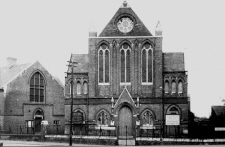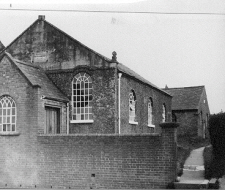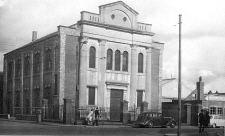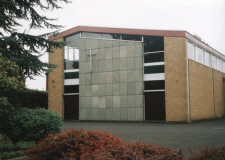METHODISM IN BLAKENHALL AND PARKFIELD, WOLVERHAMPTON.
By Peter Hickman
EARLY DAYS
(From ‘Black Country Methodism’. A Camden Pratt, 1891)
“ The Fighting Cocks is still the name of a neighbourhood, as well as the sign of a large public-house situated on and about that part of the Dudley Road where a turnpike gate very recently marked the bounds there between Wolverhampton and Sedgley, and was known as Fighting Cocks gate. The name tells of the time when the game of fighting cocks was the principal pastime of all classes, high and low, rich and poor, in the two parishes………….It took a bold Christian then to stand, the centre of attraction, where these four roads meet, to denounce all such fighting as a sin and a shame. He took his life in his hands who did it.
Yet Wesleyan local preachers were found to do it, and succeeded so far in their work as to find a roomy cottage tenanted by a man bold enough to lend it for such a purpose, they opened Sunday services there……….This was some years before Darlington Street Chapel was opened…By 1829 the Fighting Cocks society had crossed Dudley Road and progressed so far down the left-hand side of Parkfield Road as to take up it’s home in the house occupied by Mr Joseph Dainty, a charter master or butty collier.
For such a church in a house there was often a large congregation, and a room behind was frequently added to the large general room in which services were held, some fifty or sixty worshippers being thus provided for, while in Summer the front door would be left open and a score of additional around it would further increase the number of auditors…
The common life of the neighbourhood was indeed so lost, that William Cooper; one of the Superintendents of the Sunday School of Darlington Street Chapel who lived in a roomy house in Double Buildings (on Green Lanes) also opened his house for public services. Meantime Dainty’s house could no longer find accommodation for the numbers who flocked there. Ultimately it was resolved to erect a chapel between the two and the result was the Wesleyan Chapel, Blakenhall…”
DISSENTING CHAPELS
The Toleration Act of 1689, in the reign of William and Mary allowed freedom of worship to Protestant Dissenters from the Church of England who subscribed to the doctrine of the Trinity. All such dissenting congregations were required to register their meeting places with either the Clerk for the County, or with the Bishop of the Diocese.
By the Protestant Dissenters Act 1852 all registration was transferred to the Registrar General. A part of the register for Staffordshire shows the following entries: -
--A house at Goldthorn Hill Wolverhampton registered for Protestant Dissenters by Thomas Aston of Wolverhampton and Joseph Dainty of Goldthorn Hill on 27th May 1824—
Thomas Aston was the circuit minister.
--A chapel in Lanes Field Sedgley, registered for Dissenters by Robert Sherwell of Wolverhampton Minister, on 11th November 1850—
This was Parkfield Chapel. Robert Sherwell was a Minister of the Primitive Methodist Church.
--A chapel at Wolverhampton, registered for protestant Dissenters by Thomas Aston, Minister on 30th August 1825---
This was Darlington Street Methodist Chapel enlarged in 1848 and rebuilt in 1901.
THE WESLEYAN CHAPEL BLAKENHALL
The Rev T Moss opened the new chapel in 1839. Among the local preachers present were Mr Riley, Richard Dyson, T.Jackson, and William Bayliss.
The first brick was laid by old Mr Riley, the oldest preacher on the plan; but his once sturdy legs having grown too weak for even so short a journey, he was taken in her carriage by Mrs Thorneycroft (wife of G. B. Thorneycroft), and she helped him to lay the first brick and then laid the second herself!
The first Trustees Minute Book is still kept in the Wolverhampton City Archives and shows the names of Joseph Dainty, E Colman, John Lacy, M Bagnall, T. Hemmingsley, S Griffiths, Wm Summercliff, S Lloyd, J Southall, S Williams. E Williams, G Henshaw, G Spruce, J Leadbeater. R Phipps. R Fowkes.
The Chapel appears to have prospered, especially in 1849, when the cholera increased the attendance at both school and chapel!! However, by 1857 most of the collieries were worked out and many families were obliged to leave the district. Due to the efforts of the congregation led by a capable Minister Rev Edward Brice prospects improved for a time. However by 1880 it was evident that a new building was required since the premises were beyond economic repair.
RANELAGH ROAD WESLEYAN METHODIST CHAPEL
In 1884 land was purchased in Knox Road for the building of a new church. However the outlook was not considered sufficiently imposing and this land was then sold and a more promising site in Ranelagh Road was bought. The stone laying of this Church took place on Monday November 3rd,
 1885. (A document placed in a bottle under the foundation stone was
recovered in January 1965 and is now in Wolverhampton Archives). Rev Dr
Greaves conducted the opening services on 17th May 1886.
1885. (A document placed in a bottle under the foundation stone was
recovered in January 1965 and is now in Wolverhampton Archives). Rev Dr
Greaves conducted the opening services on 17th May 1886. The Sunday school still met in the old Dudley Road premises and during that time, teachers and children could be seen, each Sunday, making their way to the new Church for the Sunday morning service.
In May 1889 the old buildings were sold for £200 and land then purchased alongside the new Church in order to build a Sunday school. This was accomplished at a cost of £798 15s 0d, a sale of work raising £179 18s 7d thereto. It was then decided that such a splendid church required a proper pipe organ and funds were raised for this purpose over the next decade. In 1910 a new Nicholson Organ costing £350 was installed. (This instrument was in 1962 to be reinstalled in St John’s Methodist Church at Parkfield).
This Chapel and School prospered spiritually, financially and numerically despite the difficulties caused by two world wars. Mr. Graham Wycherley recalls that during the 1939-45 World War the Home Gaurd occupied the Sunday School so the scholars had to meet in the Church.
At one time a Band of Hope group numbered 400 children and helpers. When this fell out of favour together with weekly Class meetings and prayer meetings they were replaced equally successfully with Women’s Own, Regnal and Guild meetings.
Among the families of the Church were the Greens, Powis's, Southalls, Costley's, Tildesley's, Jones.
When Bethel Church was closed in 1955, the members of that church were warmly welcomed into the Ranelagh Road Society. They were by no means strangers since both these Churches and Parkfield were in the same sector of Darlington Street Circuit and shared the same Ministers. Amongst these the Revs. Arthur Bowes, Leslie Bickley, Matthew Brown and David Le Seelleur are fondly remembered.
When in it’s turn Ranelagh Road closed its doors in 1962 it’s members became, together with those of Parkfield Chapel, founder members of St John’s Parkfield.
PARKFIELD PRIMITIVE METHODIST CHAPEL
The Parkfield Society began in the house of Mr and Mrs Meacham in a group of cottages known locally as the ‘seven house row’. In 1849 the men of
 the chapel resolved to construct a small place of
worship using their own labours with a gift of bricks from Washbourns'
brickyard on the other side of Parkfield Road.
the chapel resolved to construct a small place of
worship using their own labours with a gift of bricks from Washbourns'
brickyard on the other side of Parkfield Road. Until 1903 the congregation sat in box pews to which stands were attached to hold candles, the only form of lighting. A Church on Snow Hill closed and Mr John Cartwright purchased the pews. With the assistance of Mr John Thornton and other helpers these were installed, together with oil lamps hanging from the beams, and a cast iron stove in the centre to heat the chapel.
At that period the Chapel was part of the Bilston Circuit but in 1916 it was transferred to the Darlington Street Circuit. At the time of this transfer, the last Minister was Rev George Anderson and the next minister in the Wolverhampton Circuit, Rev Veale.
During the 113 years of its life the Chapel was blessed with many, many, faithful servants. Among these; -
Mr Ben Ward of Lanesfield whose son Mr B G Ward attended the school becoming a local preacher.
Mrs M Banks who was born in 1851 and attended the Church until her death at the age of 62.
Mrs Eliza Hodgetts who came to Wolverhampton to be employed in service, (as Eliza Knight) in 1868 at the age of ten, from Peopleton in Worcestershire and became a leading member of the Chapel until her death at the age of 92 in 1949. (She was my Grandmother.)
Another family with long connections were the Powis’s. George Powis was a scholar, teacher, and local preacher: He emigrated to America and worked as a miner. After a short time in the mines he was ordained into the Methodist Church of America, and served for many years in Pennsylvania, eventually becoming President of the Conference of that State.
The Sunday school building was added, again a self-build, in 1858.
The chapel closed for Worship in 1962, the small congregation becoming founder members of St John’s, Parkfield.
The premises were retained by St John’s for a period after the opening of that Church, as premises for the uniformed organisations ( Scouts, Guides,Cubs, Brownies etc)
BETHEL PRIMITIVE METHODIST CHAPEL
This Society, belonging to the Bilston Primitive Methodist Circuit, began in a small building in Derry Street. A large new Chapel was built about 1860
 on the corner of Dudley
Road. With the efforts the members led by their minister Rev W H
Taylor, a new Sunday school was added in 1895.
on the corner of Dudley
Road. With the efforts the members led by their minister Rev W H
Taylor, a new Sunday school was added in 1895.A fine Nicholson and Lord Organ was installed in 1900 with generous help from Andrew Carnegie the noted American Benefactor. The organist at this time was Mr A P Jordan who gave a pair of stained glass windows depicting Hugh Bourne and William Clowes (these are now preserved in the Vestry of St John’s Parkfield)
A number of Ministers of note occupied the pulpit over the years among them, Reverends Grainger, Knapp,W H Taylor, W E Webley, Joseph Maland, John Kinnish, W H Richardson and Matthew Brown.
It is not possible to name all the members who supported and helped Bethel during it’s long history but the following families deserve a mention; -Grosvenor, George, Jordan, Malkin, Clamp, Male, Taylor, Powell, Blewitt, Wightman, Bull, Ashcroft, Stackhouse and many others to numerous to name.
The choir reached great heights under the leadership of several conductors including Messrs Wakefield, Priest, Massey and especially Theo Grosvenor, the founding leader of Wolverhampton Orpheus Male Voice Choir, who introduced many Soloists of first rank in Oratorios at Bethel.
In January 1950 the Pountney Street Mission was closed, some members went to Ranelagh Road others joined with the friends of Bethel.
In 1955 the roof of Bethel and the walls were pronounced unsafe for public use and the Church had to close. The Society then joined with Ranelagh Road Church. Their Organ was presented to the new East Park Methodist Chapel.
THE COMING TOGETHER OF FOUR SOCIETIES
For many years, Sunday by Sunday, members of Ranelagh Road and Bethel greeted each other as they passed on their way to Worship. It had been in the minds of many that their best interests would be served by combining the two Societies. But this was not done until, in 1955 an inspection of the Bethel building revealed serious structural problems. An investigation revealed that the cost of making good this deterioration was too great a figure for the Church to meet.
Therefore on November 20th 1955 the Valedictory services were held. The Minister Rev Matthew Brown and the Chairman of the District Rev Leslie Davison officiated. On the following Sunday, the Bethel members, with those from Pountney Street who had moved there in the years before, united as one Society at Ranelagh Road.
At that time there was some talk of a completely new Church, but this seemed a remote possibility. However in 1956 Miss Alice L Onions, a member of Parkfield Road died, and in affection for the old Chapel, left her entire estate in the hope that the money might be used in building a new Church. At meetings held subsequently it was strongly felt by members of Parkfield that the furtherance of the Kingdom of God could best be served by building a New Church, and incorporating all the former Societies into one body.
A suitable site was found on the Wolverhampton Road East at Fighting Cocks. This was formerly part of the garden of Mr Hill’s, Parkfield House with an area of 4000 square yards.
Meanwhile the Wolverhampton Corporation was planning the redevelopment of the Blakenhall area and after negotiations, in which the Circuit Superintendent Rev John Jackson played a major part, the Corporation agreed to purchase the Ranelagh Road site.
Without any one of these circumstances it is very doubtful whether the scheme costing £42,000 could ever have been contemplated.
ST JOHN’S METHODIST CHURCH, PARKFIELD

A ‘Founding Trust ‘ was set up consisting of members from both churches. These were; -
Jane Hewitt, George Venables, John Smallwood, Hubert Hunt, Kathleen Hunt, Theodore Cholmondeley, Percival Cliff, John Chambers, May West, Albert Wycherley, Peter Hickman, Wilfred Plant, Edwin Kendrick, Winifred Ind, Lily Holt, Harry Hewitt, Graham Wycherley, Allen Slater, Joyce Cox, Arthur Pearson, John Thornton, Joseph Cox, Leslie Feeney, Norma Venables, Frank Vale, Percy Jones, Dorothy Powis, Harold Flavell, Francis Bate, Deryk Vernon, John Taylor, Edgar Rees, Wilfred Greenway, Kenneth Lane, Raymond Cholmondeley, Maurice Lane, Dorothy Lathe, Wilfred Southall, John Wood, John Haynes, Audrey Smith, Stanley Richards, Wilfred Hopkins, Amy Harris.The site was purchased in August 1960 and in the following months the Architect, Malcolm Upright and his partner Kenneth Gallimore were engaged to design the Church. From then on many differing plans received careful and lengthy and sometimes passionate consideration. Finally agreement was reached on the design and other requirements. Several tenders were then sent out and a Wolverhampton firm, Biddulph and Thrift was engaged to build the Church.
Turf cutting took place on 22nd July 1961 performed by three young ladies- Jane Hewitt, Joyce Cox and Norma Venables. Construction of the Church building occupied the next twelve months, and then, on 18th August 1962, the Rev Leslie Davison, who at that time was the President of the Methodist Conference, conducted the opening services.
THE YEARS BETWEEN
The first Minister was Rev Deryck N Howarth who moved into the new manse on Parkfield Road. Rev Bryan Rippin followed him in 1970, and then in 1979 Rev Alan Harvey (who is at present a mission partner in Ghana) became Minister until 1987 .In 1988 there was a vacancy for the space of a year, ably filled by Sister Kath Hutton. In 1989 Rev Peter Russell became the Minister and he served the church until his retirement from the Ministry in 1995. The present (2002) Minister is Rev Dr Phillip Rees.
On Sunday 18th August 2002, the Society of St John’s celebrated its fortieth anniversary. Rev Bryan Rippin, who is now retired, gave the Sunday morning sermon. This was followed by a sit-down lunch with eighty folk present. The worship for the day ended with a thanksgiving Communion conducted by Phillip Rees.
The forty years have seen so many changes. Most of the characters of the opening are no longer with us-they were men and women who worked to create a new beginning in the Blakenhall area. Now, as St John’s faces the future it is recognised that the changing needs of today are very different to those of 1962- a changing community enlivened by many various cultures and different faiths- the increasing role of youth and the ever widening vision of the world’s needs.
So for that future-“We’ll praise Him for all that is past, and trust him for all that’s to come.